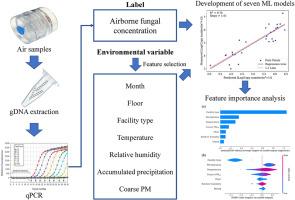利用环境变量预测公共设施室内空气真菌浓度的机器学习模型
IF 7.3
2区 环境科学与生态学
Q1 ENVIRONMENTAL SCIENCES
引用次数: 0
摘要
空气中的真菌是室内空气质量不达标的主要原因,对公众健康有潜在影响,特别是在公共设施中。通过准确预测空气中真菌的浓度,可以显著降低慢性暴露的风险。为了管理室内空气质量,我们开发了机器学习(ML)模型,通过利用环境变量(如设施类型、楼层、月份、空气温度、相对湿度、粗颗粒物(PM) 2.5-10和2天累积降水)来预测公共设施中空气中的真菌浓度。采用特异性和敏感性高的基因检测方法测定真菌浓度。梯度增强(Gradient Boosting, GB)模型在7个模型中表现出较好的性能,在测试集上的R2为0.78。采用SHapley加性解释(SHAP)分析来评价特征的显著性。根据我们的研究结果,与其他设施相比,日托中心对真菌浓度的影响最大。2 d降水对真菌浓度的影响大于极端降水对真菌浓度的影响。真菌浓度与气温、粗颗粒物PM2.5-10和相对湿度呈正相关。基于这些发现,我们可以对空气中真菌浓度和影响它们的环境变量提供基本的见解,而本文开发的GB模型可以作为评估公共设施中微生物污染的工具。本文章由计算机程序翻译,如有差异,请以英文原文为准。


Machine learning models for predicting indoor airborne fungal concentrations in public facilities utilizing environmental variables
Airborne fungi are major contributors to substandard indoor air quality, with potential implications for public health, especially in public facilities. The risk of chronic exposure can be significantly reduced by accurately predicting airborne fungal concentrations. To manage indoor air quality, we developed machine learning (ML) models that predict airborne fungal concentrations in public facilities by utilizing environmental variables, such as facility type, floor, month, air temperature, relative humidity, coarse particulate matter (PM)2.5–10, and 2-day accumulated precipitation. A gene-based assay with high specificity and sensitivity was used to measure the fungal concentrations. The Gradient Boosting (GB) model exhibited superior performance among the seven developed models, achieving an R2 of 0.78 on the test set. SHapley Additive exPlanations (SHAP) analysis was performed to evaluate the significance of the features. According to our findings, day care centers had the most substantial influence on fungal concentrations compared to those of other facilities. The impact of the 2-day accumulated below-average precipitation was more significant than that of extreme precipitation in increasing fungal concentrations. Furthermore, fungal concentrations were positively correlated with air temperature, coarse PM2.5–10, and relative humidity. Based on these findings, we may provide fundamental insights into airborne fungal concentrations and the environmental variables that influence them, while the GB model developed herein can serve as a tool for assessing microbial contamination in public facilities.
求助全文
通过发布文献求助,成功后即可免费获取论文全文。
去求助
来源期刊

Environmental Pollution
环境科学-环境科学
CiteScore
16.00
自引率
6.70%
发文量
2082
审稿时长
2.9 months
期刊介绍:
Environmental Pollution is an international peer-reviewed journal that publishes high-quality research papers and review articles covering all aspects of environmental pollution and its impacts on ecosystems and human health.
Subject areas include, but are not limited to:
• Sources and occurrences of pollutants that are clearly defined and measured in environmental compartments, food and food-related items, and human bodies;
• Interlinks between contaminant exposure and biological, ecological, and human health effects, including those of climate change;
• Contaminants of emerging concerns (including but not limited to antibiotic resistant microorganisms or genes, microplastics/nanoplastics, electronic wastes, light, and noise) and/or their biological, ecological, or human health effects;
• Laboratory and field studies on the remediation/mitigation of environmental pollution via new techniques and with clear links to biological, ecological, or human health effects;
• Modeling of pollution processes, patterns, or trends that is of clear environmental and/or human health interest;
• New techniques that measure and examine environmental occurrences, transport, behavior, and effects of pollutants within the environment or the laboratory, provided that they can be clearly used to address problems within regional or global environmental compartments.
 求助内容:
求助内容: 应助结果提醒方式:
应助结果提醒方式:


